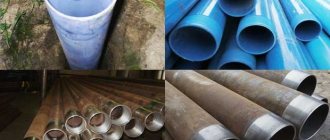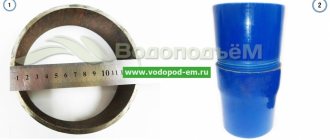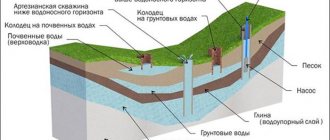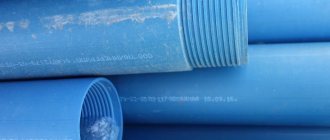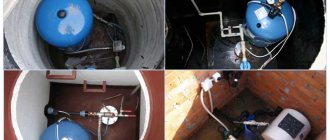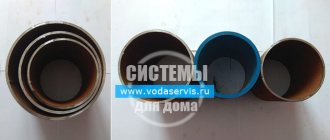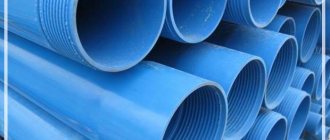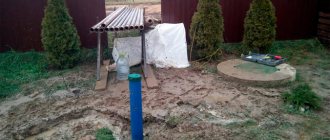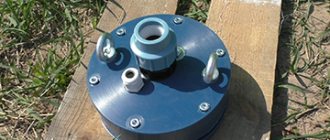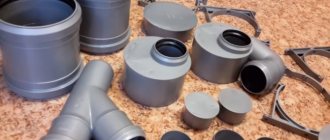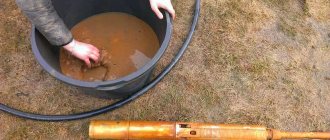One of the main tasks on a site with a private house, devoid of any communications, is to ensure individual water supply from a well or a well, while the first has several varieties. To choose the appropriate type of well source, you should know the answer to the question - artesian well, what is it.
It is worth noting that artesian-type wells are among the most expensive, both from a technical point of view, associated with the complexity of the work carried out and high installation costs, and from a bureaucratic point of view. Therefore, it is useful for any user who decides to engage in its development to study information about situations when it is necessary to formally document the drilling procedure.
Rice. 1 Types of wells
What it is?
This refers to the source of water. The main feature is that the liquid spontaneously bursts upward with powerful pressure. In some cases this source is artificial, and in most cases it is natural. The occurrence of water is located at great depths in aquiferous earth layers. When this horizon is opened, the liquid easily rises to the top.
Artesian well, what is it, design varieties
The design features of domestic artesian wells are influenced by their depth, soil composition, financial capabilities of the customer, and technology for performing work by firms or individuals. If an artesian well is drilled, how many meters its estimated depth is determined from geological maps and soil sections for the area, and based on these readings, the required structure and selection of necessary materials are planned in advance.
The main structural elements of artesian wells are pipe columns, which are divided into the following groups:
Operational. They contain water directly and a submersible electric pump is placed; the main material of manufacture is unplasticized polyvinyl chloride PVC-U. The production column penetrates through the upper layer of limestone and is located in the water basin, resting on its bottom made of similar rock. In the bottom region, the column has a filter, usually consisting of a series of chaotic round holes in the walls of the lower pipe.
Casing. Designed to form a borehole, prevent soil shedding and protect the production pipeline from transverse deformation by layers of earth. The construction of the casing is usually made of steel or plastic pipes with a threaded connection, it runs the entire depth of the shaft to the upper limestone layer lying above the water basin.
Conductor - an additional technical column placed on top of the casing, located in the upper part of the shaft and is used during the drilling process to prevent collapse and absorption of too much drilling fluid by loose sand, which must make a cyclic movement from the bottom (bottom) to the surface and inside the drill rods . The second purpose of the conductor is to prevent the penetration of surface or contaminated groundwater into the annulus and then into the water basin. The conductor, installed on top of the casing, has a limited height depending on drilling conditions.
Rice. 3 Wells with one column and conductor
Classic for shallow depths
In these types of artesian wells, the lateral load on the production casing is insignificant, so the use of metal casing is not required and PVC-U pipes cope well with the task. To accommodate a submersible electric pump with a standard outer diameter of 4 inches or 100 mm, a PVC-U casing pipe with an outer diameter of 125 mm with a normalized wall thickness of 5, 6, or 7.5 mm is suitable, respectively, the inner diameter of the column is 115, 113 and 110 mm.
To eliminate the penetration of groundwater into the space behind the column and then into the water layer, the near-pipe cavity at the top is sometimes concreted to a certain depth. Since the soil pressure on the water basin at shallow depths is not too great, the water rarely rises to a height above half the length of the shaft and therefore the submersible electric pump is mainly located in the bottom area.
With conductor
The conductor is used when many problems associated with single-pipe drilling arise. Most often, it is installed in the presence of loose soils, leading to the collapse of the borehole channel, and to seal cracks in the rock through which the flushing solution necessary for the normal drilling process escapes (lifting cuttings, creating a crust on the walls of the borehole, preventing their destruction) and cooling the drill .
The occurrence of the above problems during drilling means the cessation of drilling - drill rods with a bit are removed to the surface and drilling is carried out with a large drill diameter. Next, a steel pipe of the required height is inserted into the made channel, after which the previously started drilling operations are continued according to the same technology, inserting the drill inside the conductor column.
If standard PVC-U pipes with a diameter of 125 mm are used when constructing a casing for a submersible electric pump, a steel pipe with an outer diameter of 140, 146 mm can act as a conductor.
Rice. 4 Design of a well with two columns
Related article:
How to find water on a site for a well - folk and scientific methods . When looking for information about what an artesian well is, it may be interesting to read an extended article about the options for drilling a well or digging a well on your own and with the involvement of water specialists at the site.
With two columns
For deep penetrations, the most commonly used option is to construct an artesian well from an internal corrosion-resistant uPVC plastic column and an external mild steel casing. When drilling, they reach limestone, after which a metal casing column is installed, then the lime layer is pierced with a drill of a smaller diameter, approximately equal to the internal cross-section of the casing channel, and a PVC-U production string with a perforated filter at the end is placed into the shaft.
The need for an external steel casing pipe when drilling deep artesian wells is caused by another reason. The fact is that sometimes, when passing through a limestone layer, water from high pressure rises up the trunk and begins to gush. In this case, a plug with a tap is welded onto the upper steel pipe of the casing and water is used without the use of a submersible electric pump. If the casing had originally been made with plastic pipes, excess water pressure inside the column could have caused damage to it and made it difficult to install a shut-off valve.
Device/design
An artesian well is a special drill hole in the ground that penetrates through soil layers and is divided into:
- paramount;
- minor;
- tertiary.
The depth of the horizon is around 200 meters. The level may be lower, it all depends on the level of clean water. 4 technologies are used:
- Classic option.
- Telescopic.
- Conductor.
- With double casing.
Device contents:
- Casing string.
- Header.
- Caisson.
- Production column.
- Pump.
Positive and negative characteristics
pros:
- High quality water. Melt water, various contaminants with waste, fertilizers, etc. do not reach the water intake of an artesian well. According to the requirements of SNiP, drilling such a source is allowed at a distance of at least 300 meters from industrial enterprises, gas stations and similar objects that are potentially a source of pollution. With all this, the mouth can be easily protected from various contaminants.
- Stable pressure. Regardless of the time of year, there is a constant and stable level of water yield. Due to this, one source can provide water to several houses at once. On average, an artesian well produces up to 50 liters per hour.
- Water drilling can be done at any time of the year.
- Possibility to drill in any area of the house.
- There is no need to clean the source all the time.
- Service life up to 50 years.
Minuses:
- Drilling an artesian by hand is not so easy. There may be boulders and other obstacles.
- If a well is installed under a house, then difficulties arise due to the limited area. Because of this, achieving the required depth in such conditions can be difficult.
- Requires serious financial investments, as a large amount of equipment is used.
- It is necessary to purchase expensive and complex mechanisms, such as a filter system, to reduce the level of mineralization of water.
- A mandatory requirement is that the source be licensed by government agencies. Permits are also required.
- The head must be insulated. The best solution is to make a caisson. Will require additional costs.
What kind of well is called artesian?
In individual water supply, three types of wells are used, differing primarily in their depth. The shallowest of them, the Abyssinian, is located at a depth of 5 to 30 meters and is designed for water intake from the first surface aquifer. In Abyssinians, many homeowners drill with their own hands or with the help of hired workers who specialize in this type of drilling.
The mine is traversed with a hand drill (much less often with a bailer) of small diameter without the use of expensive and complex mechanisms or special equipment; water intake is carried out using a surface electric pump. They try to place the casing filter in the aquifer without resting on the sandy-silt bottom, so the pumped out drinking water is of good quality.
Wells in sand reach depths of 70 m; special equipment is used to dig them, and a column of polymer and, less often, steel pipes resting on a sandy-clay bottom is placed in the drilled channel. Water intake is carried out using a submersible electric pump; the water has a high content of clay and sand impurities and therefore requires improved coarse and fine purification.
When answering the question of what an artesian well is, they first of all talk about its depth, which lies in the range from 35 to 300 m. When passing through it, they reach hard calcareous rocks, above which the aquifer is located, so the water is highly transparent and lacks sand. - clay impurities. When installed in a channel, the column experiences high lateral soil loads, so the use of durable steel pipes is practiced in the well. For water intake, submersible pumps of the highest power are used - due to the significant soil pressure on the aquifer, the filling rate per unit of time (discharge) of the artesian source is the highest among other types of wells.
Rice. 2 Artesian well - device
What is the performance
On average it is 3 m3/hour. The volume is about 50 liters. A sufficient standard to provide water from one well to three cottages at once.
Good to know! High productivity is explained by the fact that it has minimal hydraulic resistance, due to the porous structure of limestone.
Operating rules
Like any other structure, the described system requires proper care and maintenance. To do this you should:
- Use the water carrier constantly as this will affect its performance. It is allowed to install the lift after drilling work. This minimizes the likelihood of clogging the installed filter structures.
- It is advisable to submit the water for chemical analysis before using it (we told you how to properly conduct a laboratory and home analysis of water from a well here). This will not only help you choose the right filter, but will also protect your body from the penetration of foreign particles. Correct selection of the filter will significantly extend the life of household appliances and pumping equipment.
- If the water well is not used for a long time, it is recommended to pump out all water from the well before using it.
- It is recommended to initially start the pump at low speeds, gradually accelerating the speed. This device should operate with pauses every 2 hours. It is advisable to pause during the initial stages of pump operation.
Proper operation will not only extend the life of the described water carrier, but will also make it uninterrupted and practically problem-free!
Water quality
According to GOST, there are certain standards. Iron levels should not exceed 1 mg per liter. Sulfates per liter no more than 500 mg. As for its hardness, this figure should not exceed 7 mEq/g.
As the level of the water horizon drops, the fluorine and mineral content in its composition increases. As a consequence, it is recommended to choose a location where the aquifer is as high as possible.
On the other hand, Jurassic clay brings iron into the water; because of this factor, they are looking for an area with the deepest water intake location.
Despite the high quality of the liquid, it needs to be cleaned. The goal is to reduce:
- Iron levels.
- Level of mineralization.
- Rigidity and so on.
Important! If you follow the technology during the drilling process and install equipment, you will be able to significantly reduce the level of various impurities.
What documents are required and how are they prepared?
The documentation and process of drilling an industrial artesian well consists of the following points:
- Obtaining a license for the right to use water resources.
- Development of design documentation and its coordination with Rospotrebnadzor.
- Carrying out drilling operations with the construction of a production well according to the project.
- Carrying out a complex of geophysical studies of soil and laboratory analyzes of water quality.
- Registration of a passport for a well, taking into account the physical parameters of water resources.
- Registration of a well and assignment of a cadastral number to it.
- Installation of pumping equipment in a caisson, house, or separate room.
- Development of design documentation for the installation of a water intake unit.
- Carrying out installation work to assemble a unit for water consumption.
As for drilling individual wells, according to the law (Article 19 of the Russian Federation Law on Subsoil), owners of individual plots have the right of ownership to commonly occurring minerals, including water resources, if three conditions are met:
- The volume of water consumed does not exceed 100 cubic meters per day.
- Extracted water resources are used to meet their own needs and not for commercial use.
- The exploited water basin must be located above the aquifer used for the needs of centralized water supply.
Since water resources on an individual plot are not listed on the state balance sheet and are actually equated to land, to drill artesian wells on private territory, their owner does not require a permitting license or any further documentation, subject to the above three points.
It is clear that only owners who install deep artesian wells in densely populated areas, where there is a high probability of ending up in a water basin used for the needs of centralized water supply, may find themselves in a difficult situation. In this case, they will have to go through all the bureaucratic procedures mentioned above to develop and document industrial wells.
Rice. 13 Artesian well with adapter - arrangement diagram
Kinds
There are five designs:
- Regular.
- With double casing.
- With a conductor.
- On limestone.
- Telescopic.
Regular
The depth of the source reaches the upper waterproof layer when drilling a hole. After this, the diameter of the drilling rig and casing are reduced. Drilling is carried out right up to the water. The deep pump is installed at a distance of 10 meters from the static level; it can be installed one meter from the pit.
With double casing
This type of device consists of using casing pipes with different diameters. The first of them is located near the boundary of the formation with limestone. The second casing is located directly in the formation and reaches the aquifer.
The second casing has perforation. Liquid passes through it. A deep water lift pump is installed in the pipe located below. This technology is used in cases where there is not enough pressure in the aquifer, and the horizon has sandy lenses and layers of clay.
With conductor
By conductor we mean a pipe that has a large diameter, unlike the casing. A conductor is installed in cases where the top layer has quicksand. Due to it, the casing pipe of a smaller diameter is protected from the pressure created by the quicksand.
How to drill an artesian well
To carry out drilling operations at a professional level, self-propelled units on the chassis of large-capacity all-terrain vehicles Ural, Kraz, and Kamaz are used. Currently, when drilling wells, the following two main drilling methods are used:
Auger. With this method, the formation of a borehole channel is carried out using auger (screw, spiral) rods (the first of them has a cutter at the end), which are gradually screwed into the ground, and new elements are added as they are immersed. The soil is lifted upward by moving it along spiral plates on a rod. Thanks to the compactness of the method and drilling equipment in the form of a small tower, augers can be used to drill wells inside a built house.
The method is characterized by high speed and ease of penetration, relatively low cost, and is designed to work in soft and loose soils of loamy and mixed type. The answer to the question from what depth the auger can lift soil will be a low maximum value of 50 m.
Depending on the characteristics of the soil, different types of end cutters are used; they can have the form of blades, round or cone-shaped heads. The disadvantages of the auger drilling method, in addition to the low penetration depth, include the inability to work in loose soils, with boulders and hard rocky, calcareous soils, as well as the limited diameter of the passage channel, not exceeding 200 mm.
Rice. 6 Well drilling based on truck tractors
Rotary. This method is classified as a modern drilling method; the through rod is a hollow pipe with a thread, at the end of which there are various types of drill bits with a screw-in threaded pipe. As the drill is immersed, hollow rods are connected to the passage pipe, through which drilling fluid is supplied into the borehole channel - polymer or clay bulk compositions diluted in ordinary water with various additives. Thanks to hydraulic drilling technology, the productivity of the rotary method reaches 300 m per shift, and its main advantage is the ability to penetrate hard limestone and rock formations.
The rotary method makes it possible to obtain well channels of significant diameters for industrial use; it makes it easier to drill complex wells with several conductors or casing strings. The disadvantages include the higher cost of the work and the need for additional equipment in the form of a special supply and suction water pump, a water tank on the car.
Rice. 7 Auger and rotary drilling
It is clear that only the rotary method is suitable for drilling an artesian well; the process of constructing a standard source of two shells using the core method consists of the following steps:
- First, preparatory operations are carried out; for this purpose, two pits (sumps) are dug, connected to each other and to the wellhead (exit) by grooves at a distance of no more than 1 m from the drilling point. The first sump is used to collect slurry water, which is dissolved and extracted soil from the mine; the second sump is used to collect the drilling fluid that has settled from the sediment. Many drillers do not complicate the preparatory process and use one pit with a groove from the wellhead - the washing liquid is collected in it, and the cuttings are thrown aside with a shovel as the ditches and sump are filled.
- A core pipe is prepared for penetration to the limestone layer, a shank is screwed to it at one end, and a cutting part in the form of a crown with protruding carbide pobedite teeth with a diameter of 132 mm is placed on the other (later it cuts into the limestone and remains in it together with the core pipe) and hang it from the elevator of the car.
In this version of the excavation under consideration, a core pipe with a pobedite bit is first used; many drillers punch the soil at all stages with a roller bit.
Rice. 8 Pobedit drill bits and roller bits
- The suction hose of the pump located on the vehicle and the outlet hose from the tank are immersed in the sump, the sump is filled with water from the container, and the mixture for preparing the drilling fluid is poured into it from the bag.
- Turn on the pump that supplies the prepared solution inside the hollow core pipe, and begin drilling. As it progresses, additional drill rods are connected to the column; before operation, their threads are coated with graphite lubricant.
- Since the walk-through core pipe with a pobedite crown is hollow, during the immersion process it periodically becomes clogged with clay, so it is removed to the surface at certain intervals and washed.
- After the crown comes into contact with the limestone (determined by flushing through a sieve), construction of the casing begins. To do this, the column with a pobedite crown is removed to the surface by dismantling the rods.
Rice. 9 Preparation for drilling
- They begin to install the casing (often using inexpensive steel pipes with an outer size of 133 mm and a wall thickness of 4.5 mm), and the first columns with a crown are placed in the shaft. As they are immersed, the pipes are connected to each other using conical threads applied to their internal and external walls; before starting work, they are coated with graphite lubricant.
- To rotate the pipes during the threaded connection as they are lowered into the drilled shaft, an end cap is used, which is screwed to the threads of the upper pipe and placed in the rotating elevator of the drilling machine.
- After installing the steel casing on the limestone, the entire column is screwed into it dry. This is necessary for hermetically cutting off surface and groundwater from the aquifer basin, which can penetrate into the bottom area (bottom area) of the source and deteriorate the quality of drinking water.
- Using a grinder with a metal disc, cut the last pipe at a height of about 0.5 m from the ground surface.
- A roller bit made of high-strength tungsten carbide, designed specifically for punching hard rock, is screwed into the smaller end pipe, and penetration is continued using rods. Drilling is carried out until the upper layer of limestone passes through the water basin and to the lower layer; to immerse into it at a distance of 3 - 5 m, a bit of an even smaller circumference is taken. This is done so that the resulting depression in the bottom acts as a settling tank for fine fractions.
Rice. 10 Initial stages of drilling operations
- After removing the column with a roller bit from the shaft, the installation of a production string made of PVC-U begins. For the above diameter and wall thickness of the steel pipe, the internal passage channel is 124 mm and for immersion into it, a PVC-U pipe with a standard outer diameter of 113 mm and a wall thickness of 5 is better suited. mm, the passage channel for the submersible electric pump has a value of 103 mm.
- The first to be lowered into the shaft is a filter with hole perforation - unlike installation in sand wells, it does not have a conical plug at the end and a settling area. Next, PVC-U pipes are screwed to the filter, rotating them using an adjustable end cap, the latter is cut off at the level of the steel casing, and at this point the installation of the well can be considered complete.
- Since in an artesian well, unlike a sand well, there is clean water without impurities, it does not need to be pumped using reverse supply technology from a tank into a hermetically sealed well channel under pressure. A deep-well electric pump is immersed in the well; hollow drill rods are used as a holding cable and pressure pipeline, to which the unit is screwed through an adapter. After pumping out a certain volume, the water in the well usually becomes clear and suitable for domestic use.
- At the end of the drilling process, the owner of the site is issued a passport for the well indicating its technical parameters (height and diameters of the columns), flow rate, static and dynamic levels.
Determining the location for artesian wells in the country
Consider these points:
- The specific location of the source.
- The location where equipment will be installed on site.
- The area where process water will be drained.
- Determination of the working area.
The site must be at least 4 by 9 meters in size. This is explained by the need to install special drilling equipment. If a machine is used, its mast height is up to 10 meters. Therefore, there should be no electrical wires in this location.
A map of your region can help you find out exactly where to drill. Moreover, there are standards for distance from certain objects:
- From industrial enterprises and other potentially hazardous pollution sites at a distance of no closer than 300 m.
- Closer than 200 m from sewers, burial grounds, landfills.
- No closer than 30 m from houses and other buildings.
Advice! It is extremely important to study the area and make sure that there are no communications running underground.
Pros and cons of artesian wells
Artesian springs have the following positive properties:
- Drilling operations take a short period of time; in soft rocks, the penetration speed reaches 300 m per shift, and the average drilling speed when installing two columns averages about 40 m per day.
- The water extracted to the surface does not contain sand and clay impurities - this allows you to save money on coarse and fine filters.
- Also, the deep location of artesian water basins prevents the penetration of surface contaminated water, microbes, pathogenic bacteria, harmful effluents from septic tanks, industrial enterprises, and open cesspools into the source.
- The definition of an artesian well implies a service life of 50 years or more, while sand wells operate on average no more than 5 years.
- Artesian sources have the highest debit - this allows them to be used for water supply not only for individual residential buildings, but also for small private settlements, dacha cooperatives or high-rise buildings using industrial excavation methods.
- Artesian-type well sources, unlike sandy ones, do not require periodic maintenance, and they are not at risk of silting during long breaks in water consumption.
Disadvantages of artesian wells:
- The main disadvantage of an artesian well is the high cost of drilling, which often requires payment for the use of two columns.
- Also, crystal clear artesian water often has increased mineralization - it contains salts of iron, potassium, manganese, and sometimes contains hydrogen sulfide. These chemical elements for extraction from water masses require the use of deferrization plants and other types of purification, which are expensive to purchase and operate.
- Since artesian water basins are classified as strategic water resources, drilling wells may require approval of a significant package of documents and the fulfillment of a number of necessary conditions when placing them. The main prohibitory norms are as follows:
- All residential buildings and plantings on the site must be no closer than 30 m to the well.
- Sources of biological pollution (sewage basins, filtration fields, farms) must be located no closer than 200 mm, chemical plants, auto repair shops and gas stations - within a radius of 300 m.
- The distance between two wells must be at least 100 m.
Related article:
Well in the country - methods and stages of drilling, arrangement . It may be interesting to learn in more detail about the types of wells in the country, possible drilling options, as well as methods for their arrangement
Rice. 12 Installation diagram for deferrization for home
Tools for DIY digging
Equipment depends on soil type. For example, the rotary method is used for limestone. A special installation rotates the drilling elements.
A bit is used in the construction of a telescopic well. As the drill goes deeper, a smaller diameter bit is used.
A tripod is used if drilling is done with your own hands. An electric drive is installed on it to automate the process. In this case, a special rod with a drilling head is used. If the soil is relatively soft, a spoon drill is used.
Types of drilling
Depending on the composition of the soil and the level of water intake, different technologies are used.
Clay soils
A coil is used with a minimum amount of pebbles and gravel in the soil, mainly in loam and clay soil. Its design includes a head, a rod and a spiral coil, at the bottom of which there is a blade. It gradually cuts off the rock and goes deeper into the soil.
Hard rocks
In such conditions, a drill bit is used. It should be made from strong grades of steel. There are I-beams, crosses and chisels; some have a 90-degree sharpening angle. You can go through a small boulder with a pyramidal chisel; it crushes or moves it.
How to drill a well on limestone with your own hands
- A hole is drilled using an auger.
- The pit must be equipped with a casing pipe. It is selected based on the soil layer: plastic or steel.
- Next, the casing is clogged. The casing should be one meter or more into the clay soil layer. This prevents the penetration of groundwater.
- To get into the limestone layer, drilling continues through the casing. The diameter of the pit in limestone will be smaller. You can use hydraulic drilling technology using a special hydraulic device or, for example, a pneumatic hammer, auger, etc. The main task is to penetrate the interlayer layer.
- When the required depth is reached, all rock should be removed from the pit.
- Next, a plastic pipe is lowered, which will protect the limestone walls from erosion. The result is a two-pipe well. The bottom of the pipe should be perforated so that liquid can penetrate through it.
After this, installation of ground equipment is carried out.
Sequence of drilling work
- Loosening the rock.
- Collecting cuttings from a well.
- Insertion of casing pipes.
- Installation of water pumping equipment.
Further arrangement
Ready-made water supply system from an artesian well
After drilling a well, a number of mandatory works need to be carried out:
- Installation of a caisson made of plastic, concrete or steel.
- Installation of a deep-well pump.
- Installation and adjustment of electrical wiring and equipment.
- Installation of an automatic unit and hydraulic accumulator.
- Laying pipes to water intake points.
- Design of the appearance of the well. There is complete scope for imagination; you can decorate it as a beautiful well or gazebo.
Our other article describes in detail how to drill a well on a site with your own hands in the sand and what you will need for this.
A comparison of wells and boreholes according to various parameters is presented in this site material.
Several methods for making borehole caissons are here https://okanalizacii.ru/vodosnabzhenie/skvazhina/kesson-dlya-skvazhiny-svoimi-rukami.html
What to do if the pit fails
Determine the cause of the problem. Breakdowns can be repairable or irreparable. For example, an unresolved breakdown is caused by poor pipe insulation, poor-quality pipe connections, incorrect choice of filter, etc. If you carry out the drilling process correctly and follow the equipment installation diagram, these problems can be avoided.
In some cases, it is possible to fix the problem. For example, cleaning the filter by pumping water to clean it can help. Sometimes it is better to contact specialists who can quickly determine the cause.
